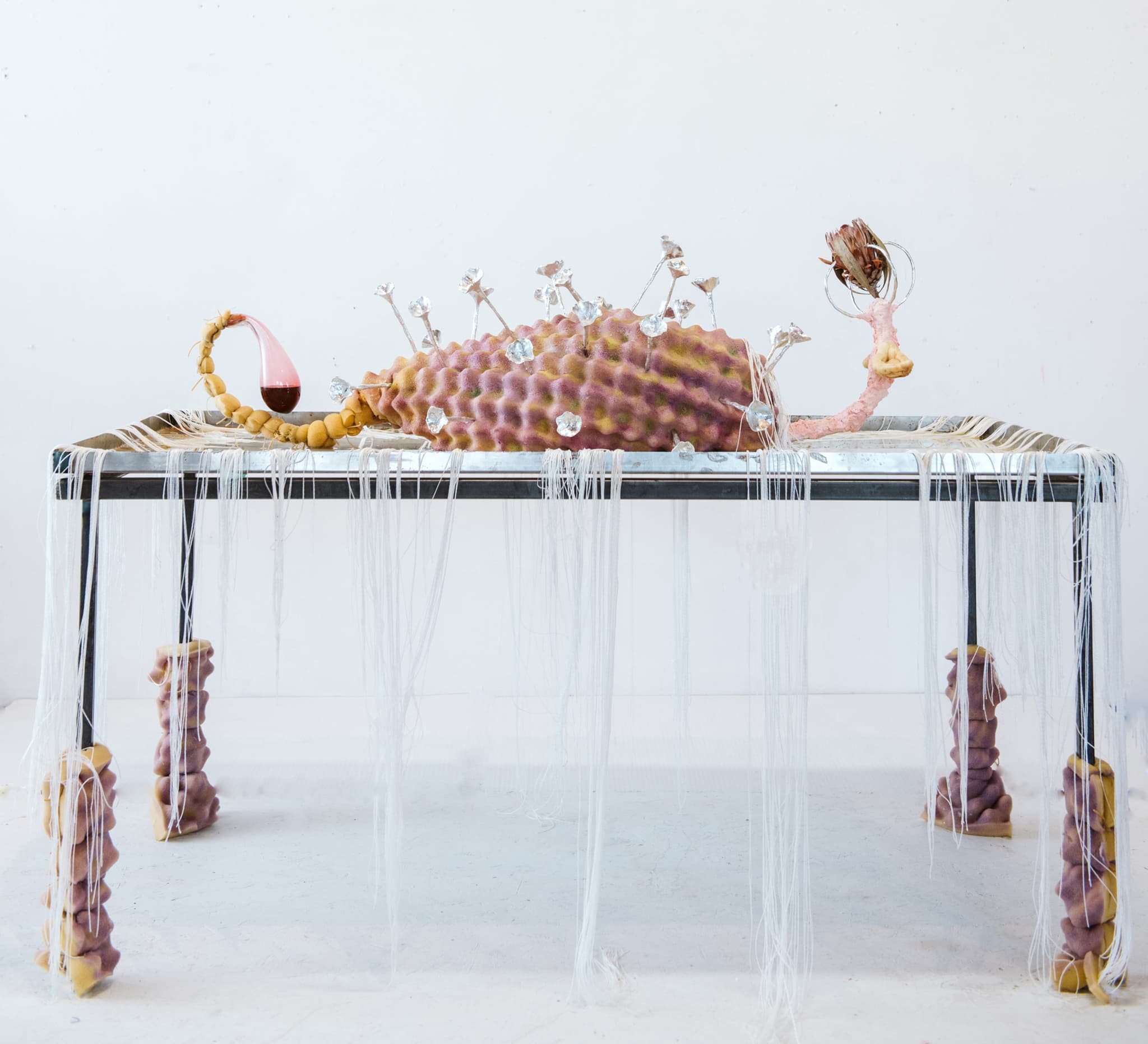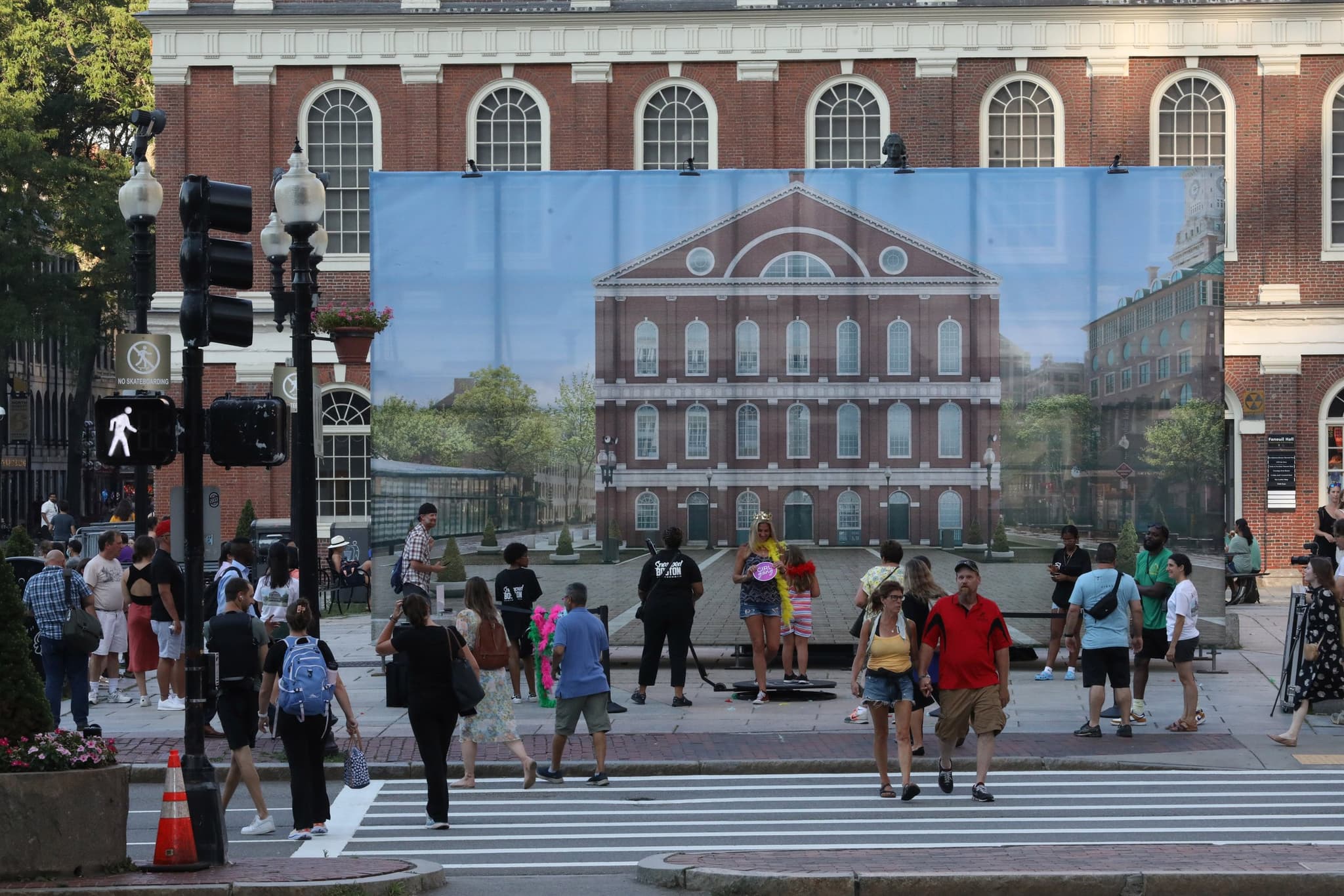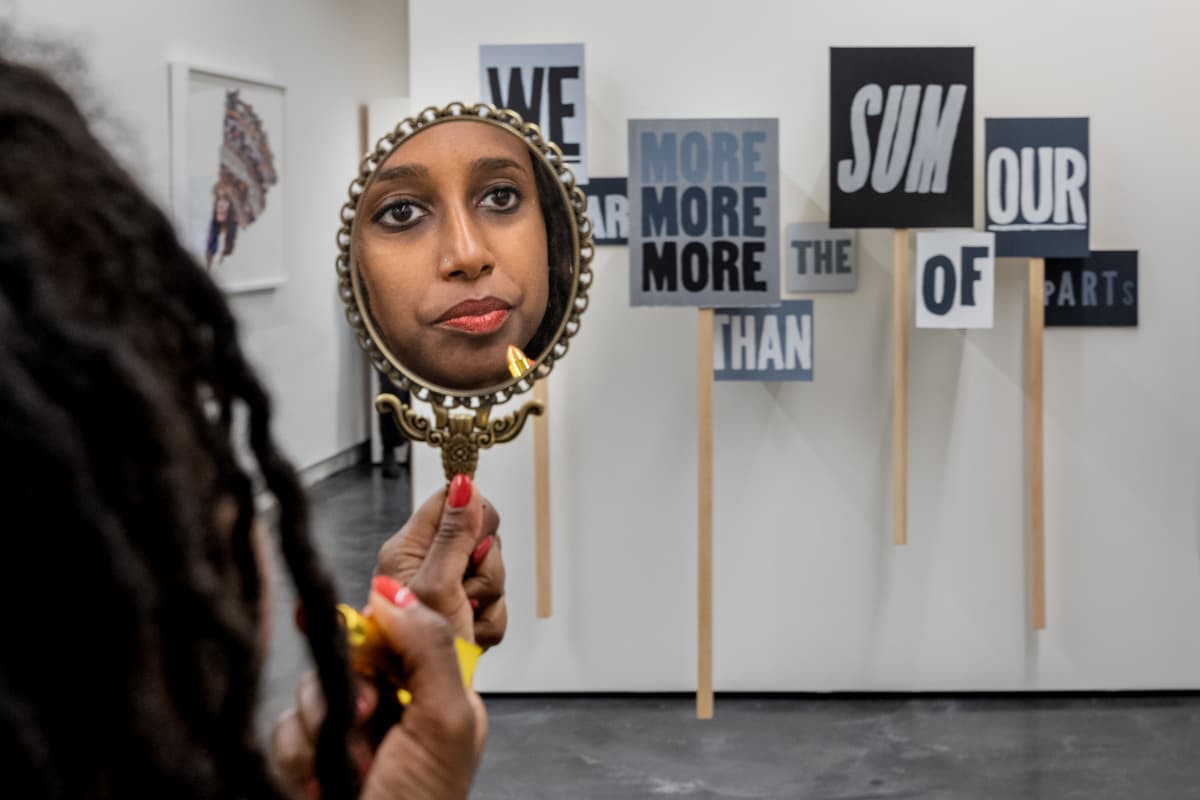“It’s so nice to be in the same space” was a familiar phrase heard at openings and community gatherings this past year. Indeed, 2022 felt like a year for healing and celebrating, along with moments of persevering. The art that graced gallery walls and cropped up in public spaces had a similar energy. As we round the corner on another year, our editors took some time to reflect on their favorite art moments of 2022.

Sir Zanele Muholi, “Being Muholi: Portraits as Resistance,” installation view, 2022. Courtesy of Isabella Stewart Gardner Museum. Photo by Sean Dungan.
In 2019, South African artist Sir Zanele Muholi was an artist-in-residence at the Isabella Stewart Gardner Museum. Earlier this year, Boston was treated to a rare viewing of some of the portraits created during that stay with “Being Muholi: Portraits as Resistance,” a solo show in the museum’s Hostetter and Fenway galleries. The shots, part of the artist’s Somnyama Ngonyama, Hail the Dark Lioness series, shared the space with other photographs spanning their decades-long career, along with more recent paintings and a bronze sculpture; the nine acrylic portraits hung bright and brazen amid the stark black and white of Muholi’s customary medium. The work itself was exquisite and disarming, enough on its own to make it one of my top shows, but what moved me the most was the considered community engagement, from the celebration of Muholi’s chosen LGBTQ+ family to the inclusion of Boston’s poet laureate, Porsha Olayiwola, whose ekphrastic poems adorned two areas like bright constellations. The result was a mix of grand and familiar, majestic and intimate, a lush complement to the Gardner’s long tradition of guarding and championing creative community. —Jessica Shearer

Samantha Fields, Diamonds & Grapes, 2022. Hand-woven cloth, crochet, beading, embroidery, yokes, tri beads, synthetic hair, grapes, pipe fittings/nipples, table legs and finials cast in vitreous china, repurposed bed spread, afghan, and table. 83″ × 66″ × 38″. Image courtesy of LaMontagne Gallery.
“Space Between the Warps,” LaMontagne Gallery, February 18–March 22, 2022
Samantha Fields’s delightfully detailed works—where craft meets installation meets geometric painting—are always deliciously complicated; their sumptuous juxtapositions of familiar materials (like lace and pipe) hold sly little stories. “Space Between the Warps” thronged with such riddles, elegantly portrayed in shifts in scale and texture. The smallest works were palm-sized tongues with dark red velvet on one side and light pink ceramic on the other; the largest was the show-stopping 83-inch-tall Diamonds and Grapes, its title yet another graceful story of contrasts. Fields is at her strongest when she’s bringing the disparate together, filling a space to its fullest, which is just what “Space Between the Warps” did. —Leah Triplett Harrington

Installation view, “MFA 2022 Exhibition” at Stone Gallery, 2022. Image courtesy Boston University Art Galleries.
I stumbled across Boston University’s MFA exhibition at Stone Gallery and discovered a treasure trove of eighteen emerging artists. The group of painters and sculptors started their MFA studies in fall of 2020, a uniquely peculiar time to fortify one’s artistic curiosities. Although it’s difficult to say how a practice is shaped by a landscape of anxiety and confusion, the exhibition revealed the confident, singular prowess of each artist. Standouts included Jada Haynes’s welded steel “Thunderbox” sculptures, Eva Lewis’s technicolor scenes of domesticity, Meghan Murray’s visions of uncanny nostalgia, and Madeline Norton’s ghostly figures exchanging secrets. —Maya Rubio

Rixy, Now What Kind of Knucklehead Told Y’all To Go This Way?, 2022. Paper, spray paint, acrylic, ink, marker, thread, and fire on treated cardboards, with paracord. Courtesy of Trustman Art Gallery.
“Enter the Cúcala,” Trustman Art Gallery at Simmons University, April 4–May 13, 2022
Rixy’s “Enter the Cúcala” at Simmons’ Trustman Gallery is one of the best displays of worldbuilding from an exhibition that I’ve seen all year. This series of paintings and mixed-media assemblages crafted its own immersive, intimate universe, led by a cast of expressive femme Black and brown characters combating toxic masculinity, transcending their traumas, and being their full, fluorescent, unapologetic selves. Conceived as part of a multi-step project, “Enter the Cúcala” was just the beginning of Rixy’s larger vision for space activations and public engagements, and her world now extends beyond the gallery through her large-scale mural Pa*Lante, completed this fall through the Now + There Public Art Accelerator program and on view at 301 Highland Street in Roxbury. I can’t wait to see what’s unlocked next from the Cúcala universe. —Gina Lindner

Estefania Puerta, Medicina Fantasma, 2021. Foam, aluminum leaf, epoxy, silk, glass, plant, latex, pastel, oil, ghost pipe tincture, plaster pulp. Courtesy of the artist and deCordova Sculpture Park & Museum. Photo by Sam Simon.
“New England Triennial,” deCordova Sculpture Park & Museum and Fruitlands Museum, April 8–September 11, 2022
I’ll admit I had my doubts when the Trustees announced that the New England Triennial would be spread across two of their art museum destinations, the Fruitlands and deCordova. Group exhibitions that end with “ennial” are, after all, an opportunity to catch glimpses of a region’s artistic zeitgeist all in one place. Yet the resulting exhibition was a thoughtful and eclectic display of twenty-five artists whose work spans disciplines and crafts and who hail from across the Northeast. From immersive video installations to innovations on age-old woodcarving techniques, this year’s triennial was successful in showcasing lesser-known artists alongside local stars. A standout was Vermont-based artist Estefania Puerta’s montages of fur, latex, tinctures, and talons that made you feel like you were stepping into the stillness of a scene moments after something totally bizarre had occurred. —Jameson Johnson

Juan Obando, Summer Sets, installation view, 2022. Photo by Dominic Chavez courtesy of Now + There.
Statues and monuments have become subjects of contentious and reparative dialogues as we consider the impact of symbols and stories in public space. Conceptual artist Juan Obando has frequently worked with screens and banners to playfully and critically prod at social and cultural phenomena. At Dock Square, in front of Boston’s Faneuil Hall, Obando erected a photorealistic mockup of what the busy plaza might look like without a towering statue of Samuel Adams. The resulting installation bore a resemblance to the screens that sometimes pop up around construction projects, and at certain angles, a visitor might not even realize what was missing from the scene. Presented by Now + There, the “set” invited audiences to snap photos and insert their voice into the dialogue but also offered a stage for community programming throughout the summer. While the installation certainly provided a prompt for our community to reimagine monuments in public spaces, we are left to consider what comes next for contending with our city’s sometimes fraught histories. —Jameson Johnson

Installation view, “We Interrupt This Program” at Howard Yezerski Gallery and LaMontagne Gallery, 2022. Image courtesy of the galleries.
“We Interrupt This Program,” Howard Yezerski Gallery and LaMontagne Gallery, August 5–27, 2022
“We Interrupt This Program” had a quick run, but it included a number of Boston-based rising stars. In fact, it was the first place I had a chance to see in person Issue 09 cover artist Andy Li’s charmingly offbeat embroidered flags and recent Artadia Award recipient Shantel Miller’s boldly pigmented examinations of emotion and connection on canvas. It also introduced me to some other standouts, including but not limited to Brian Smith’s environmentally minded pieces (such as his timely nod to Robert Smithson, Mirror Displacement After Smithson: Maine Sunrise Through Wildfire Haze from the North American West), Katie McColgan’s examinations of everyday objects in ceramic, and Isabelle Higgins’s commanding yet tender oil painting A Ship of Our Own. The number of works almost made each object compete for attention, but as a brief introduction to a group of talented emerging voices, it made an impression. —Karolina Hać

Installation view, “To Begin Again: Artists and Childhood,” the Institute of Contemporary Art/Boston, 2022. Photo by Mel Taing.
As someone who copyedits children’s books by day (and as a new parent), I was excited to see “To Begin Again: Artists and Childhood”—but the seventy-plus works on view offer something for everybody who’s been a kid. The exhibition opens with a room of unsettling figurative sculptures, from Karon Davis’s plaster-cast playmates, eerie in their stillness, to Berenice Olmedo’s herky-jerky kinetic work made from a child’s leg braces, which struggles to rise from the gallery floor. It ends in exuberance with selections from Oscar Murillo’s Frequencies, featuring canvases dense with doodles from months-long stays atop school desks. In between are rich explorations of caregiving and power dynamics, dives into children’s literature, and grown-up attempts to channel kid creativity, like Brian Belott’s “forgeries” of children’s drawings culled from early childhood educator Rhoda Kellogg’s vast archive. Affecting but devoid of schmaltz, it’s a show that puts the complexity of childhood on full display. —Jacqueline Houton

Exhibition view, “Symbionts: Contemporary Artists and the Biosphere,” MIT List Visual Arts Center, Cambridge, 2022. Photo: Dario Lasagni.
Cellar spiders, fecal clay reliefs glazed with human breast milk, and a hydraulic network filtering local wastewater into a living ecosystem, oh my! Featuring an international group of fourteen multidisciplinary artists, “Symbionts” considers organisms that thrive through their interdependent relationships. The soundscape of howling wolves in Alan Michelson’s moving image installation Wolf Nation triggered an intrinsic response as I felt called to follow or join. The exhibition is a living network of fungi, algae, beeswax, sculpture, video, and gallery goers, illuminating the beauty of natural systems and interconnectedness. —Maya Rubio

Juan José Barboza-Gubo, Retorno, 2022. Found boat, carved wood, carved acrylic. 92” x 78” x 43”. Image courtesy of Praise Shadows Art Gallery.
“Return-Eternal-Return,” Praise Shadows Art Gallery, November 18–December 23, 2022
Juan José Barboza-Gubo transformed a visit to the intimate Coolidge Corner gallery into an affective journey through the Peruvian jungle. Much of the work was sourced and created in Peru, including a boat the artist found along the Amazon River that lay the foundation of the exhibition centerpiece, Retorno (“Return”). Carved wooden branches and pigmented acrylic curled around the structure, and it felt mystical and sentient, like touching the sculpture could reveal age-old secrets. Paintings had a similar presence; as I stood across the epic Busqueda/Reencuentro, frosted acrylic appeared like dancing shadows, morphing and shining in the sunlight. A three-channel soundscape created by Barboza-Gubo and Peruvian sound artist Ronald Sánchez intensified the immersive quality as mysterious noises of the landscape reverberated through the gallery. A spiritual wisdom emerged as pieces evoked cyclical life processes of venturing out and returning to ourselves anew, yet somehow the same. —Maya Rubio

Helina Metaferia’s performance The Willing. Photo by Edward Boches for Praise Shadows Art Gallery.
Best Performance: The Willing by Helina Metaferia, part of “All Put Together,” Praise Shadows Art Gallery, March 18–April 17, 2022
New York-based artist and SMFA alum Helina Metaferia’s celebrated collage portraits enshrine their subjects in archival artifacts depicting the complex histories that beget and spur their activism. Her performance The Willing, presented in early April in support of “All Put Together” at Praise Shadows Art Gallery, engaged with a different kind of lineage, her actual bloodline. Donning a hand-wrought brass crown and patchworked screen-printed robe, she graced the audience with a looping, incantatory retelling of her matrilineal family history, beginning with her great-grandmother in Ethiopia. While Metaferia enacted the bulk of the piece herself, it was closed by her young niece, Sela Woldeyes—serene and regal—singing and circling the space, taking the action forward into the future. The illuminating talk that followed at the Coolidge Corner Theatre—led by Wellesley professor and scholar Nikki A. Greene—offered generous insight into the performance, the show, and her practice. The talk highlighted a truth the performance evoked: that we are all brimming with ancestors and incidents that inhabit who we are and inform who we become. —Jessica Shearer

A booth at the Boston Art Book Fair. Photo by Melissa Blackall.
Best Community Event: Boston Art Book Fair, Cyclorama at Boston Center for the Arts, November 4–6, 2022
After a two-year hiatus due to COVID, the Boston Art Book Fair came back with a bang: three days of 140 exhibitors, seven public programs, and a sold-out Preview Party. We loved reconnecting with our local community of artists and small businesses and meeting other publications and collectives from across New England and beyond who are keeping the art of print alive. Most of all, we loved celebrating the launch of Issue 09: Burnout in person with both new and familiar faces, presenting fresh-printed copies to featured artists and contributors, and having joyful encounters with BAR subscribers and supporters. Fairs of this scale are always overwhelming—especially for our wallets—but the thoughtful programs and one-on-one engagements between booths made for some really meaningful, intimate moments of conversation, connection, and community. We’ll be holding this year’s book fair hauls and memories close to our hearts for years to come. —Gina Lindner
Karolina Hać is an editor at Boston Art Review and head of marketing at Höweler+Yoon Architecture, LLP.
Jacqueline Houton is senior editor at Boston Art Review and a copyeditor at Candlewick Press.
Jameson Johnson is editor-in-chief at Boston Art Review and marketing and development manager at MIT List Visual Arts Center.
Gina Lindner is communications manager at Boston Art Review, an arts writer, and an interdisciplinary artist.
Maya Rubio is an independent curator and an editor at Boston Art Review.
Jessica Shearer is an editor at Boston Art Review and director of communications and user experience at the Boston College Center for Corporate Citizenship.
Leah Triplett Harrington is curator at Now + There and editor-at-large at Boston Art Review.
* Boston Art Review is run by a primarily volunteer team of editors, which means that many of us have day jobs at various arts institutions and organizations in Greater Boston. Each editor’s selection was made independently.












